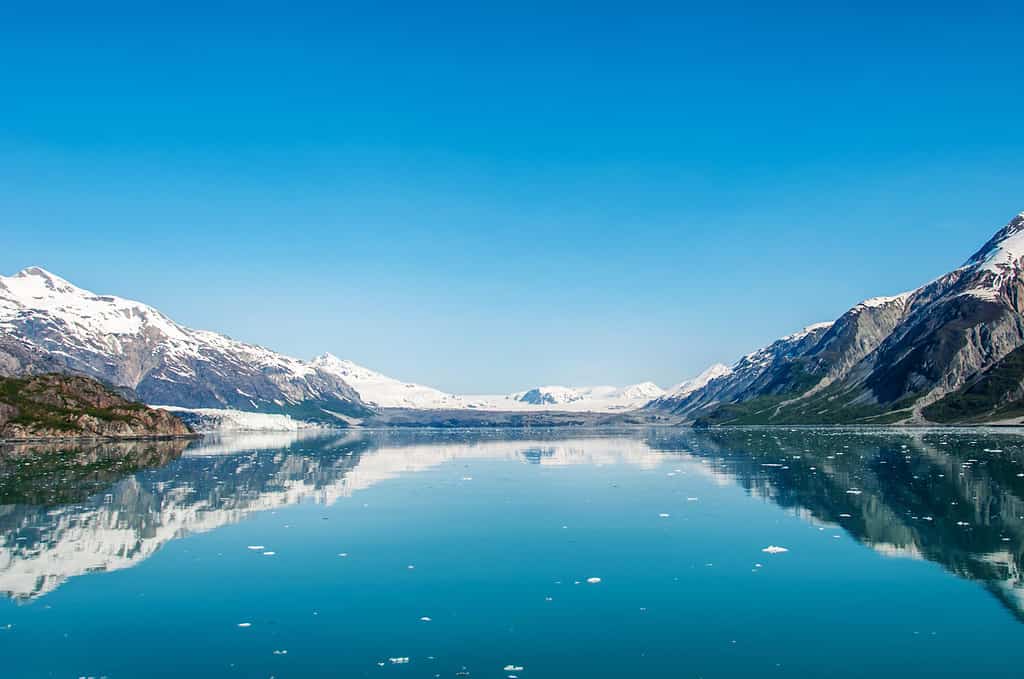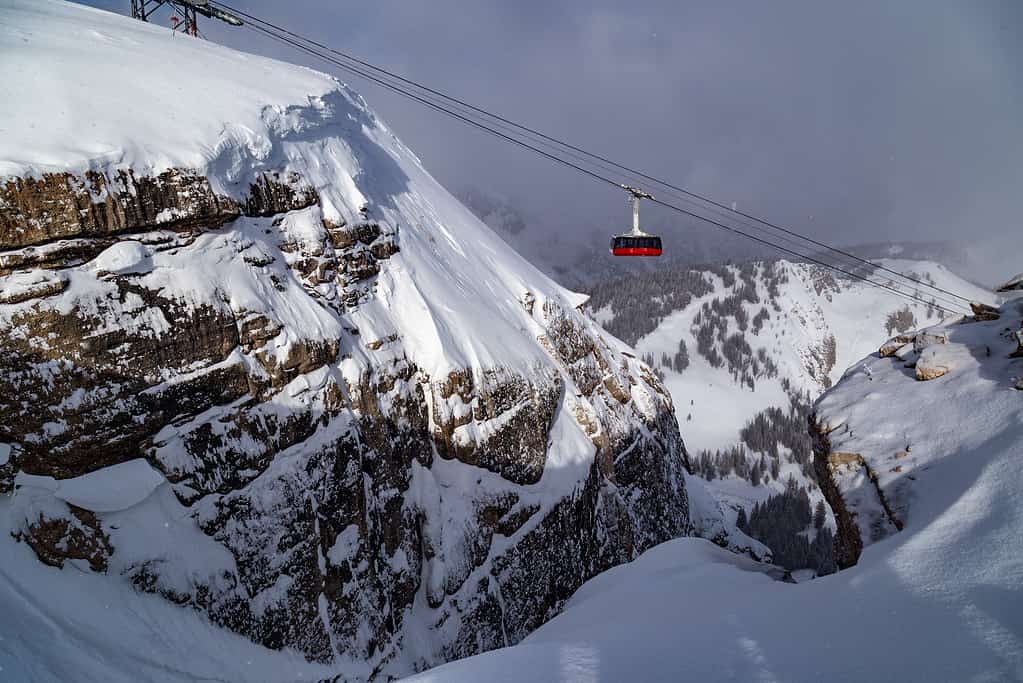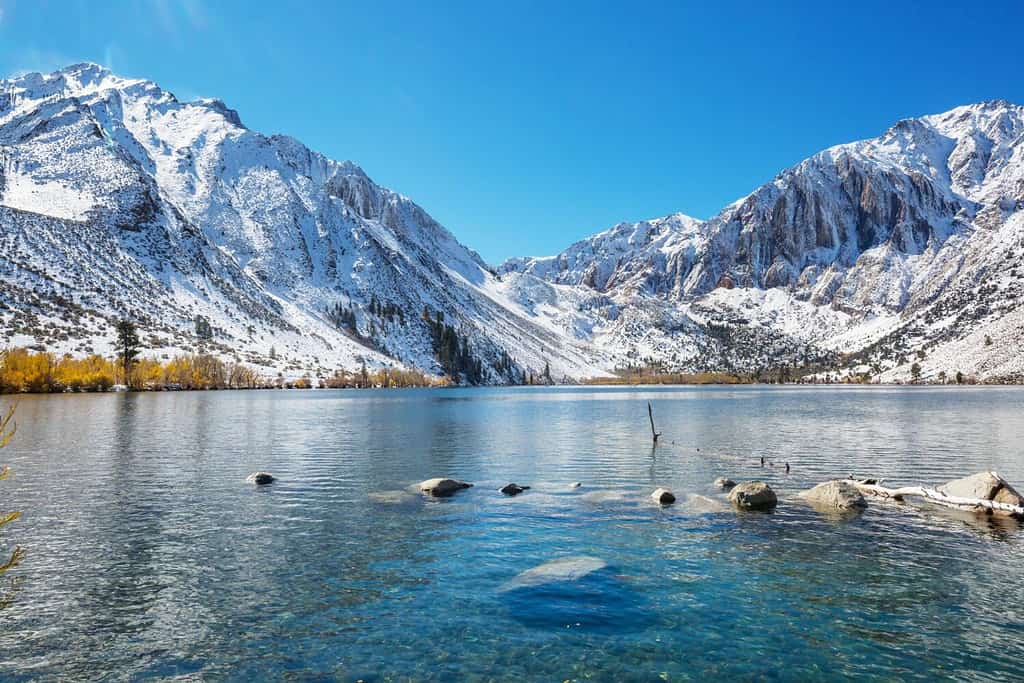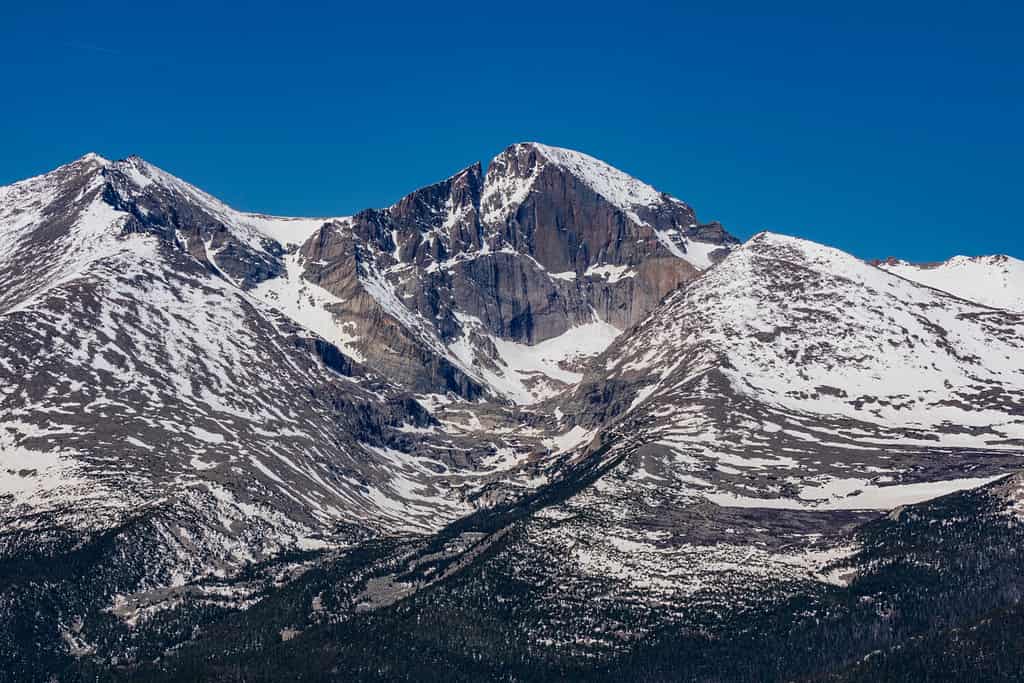Glaciers are ancient heaps of ice that form from compacted snow over a very long time. They’re like frozen rivers, slowly moving downhill, and are essential for our planet’s balance. While a vast majority of the world’s glaciers are located near the North and South Poles, some are closer to home. In fact, certain states of the United States even have glaciers!
Today, we’ll take a little journey through the 8 U.S. states that still have glaciers. These icy wonders are like nature’s time capsules, preserving stories of our planet’s past and reminding us of the incredible diversity of landscapes right here at home.
1. Alaska

Most of the glaciers in the USA are in Alaska.
©Grey82/Shutterstock.com
Alaska, often called the “Final Frontier,” is a unique state located in the upper left corner of the U.S. Alaska does not share a land border with any other U.S. state as it is located northwest of Canada. Most of the glaciers in the United States are located in Alaska. In fact, outside of Greenland and Antarctica, Alaska is home to 13% of the world’s Glaciers. This state is home to more glaciers than anywhere else in the country, featuring close to 100,000 ice formations that span over 30,000 square miles.
Among them, approximately 664 glaciers have been named and documented according to the Geographic Names Information System (GNIS). Some of the most accessible glaciers are near Anchorage, with 60 glaciers within just 50 miles of the city. Glaciers make up about 5 percent of Alaska’s vast expanse.
These glaciers are primarily situated in the middle to southern regions of the state, including within six national parks: Lake Clark, Katmai, Kenai Fjords, Wrangell St. Elias, Denali, and Glacier Bay.
The largest glacier in the U.S. is the Bering Glacier, located close to the Alaskan town of Cordova. It stretches an impressive about 126 miles and blankets an area larger than 1,900 square miles.
If you are looking for an easily accessible glacier in Alaska, the Matanuska Glacier takes the spotlight as it is accessible by road. Situated just two hours north of Anchorage, this glacier extends 26 miles in length and spans four miles in width. It’s a popular destination with many guided tour experiences available.
Effects of Climate Change
Climate change is hitting Alaska’s glaciers hard. The state is warming up two times faster than the rest of the U.S. Sadly, almost all of Alaska’s many glaciers are getting smaller, staying the same size, or pulling back. According to one study, Alaska’s glaciers are the fastest melting ones on Earth.
2. Washington

The state with the largest amount of glacier coverage in the lower 48 states is Washington.
©Tobin Akehurst/Shutterstock.com
Known as the “Evergreen State,” Washington is in the upper left corner of the continental United States.
Washington boasts numerous mountainous regions adorned with alpine glaciers. Precisely, there are 3,101 glaciers in the state, although only 186 of them bear names. Washington State takes second place in the U.S. (first in the contiguous U.S.) for its extensive glacial coverage, with a total area of 173 square miles of glaciers.
North Cascades National Park in Washington is home to over 300 glaciers and numerous expansive snowfields.
Mount Rainier, the tallest mountain in Washington, is a prominent feature of the state’s landscape and boasts 25 major glaciers. Additionally, numerous unnamed snow or ice patches adorn its slopes, covering approximately 35 square miles of the mountain’s surface.
Emmons Glacier is not only the largest glacier in Washington but also the largest in the lower 48 states. The Carbon Glacier holds the record in the continental U.S. for the lowest terminus altitude. It sits at just 3,600 feet above sea level!
For those seeking the best views of glaciers in the North Cascades National Park, going on a day hike along the Cascade Pass and Sahale Arm Trail is a must. These trails offer a close-up encounter with the Sahale Glacier, making for a breathtaking experience.
Similarly, for a spectacular view of the Emmons Glacier, a hike along the 7-mile round trip Glacier Basin Trail within Mount Rainier National Park is the way to go.
Effects of Climate Change
Sadly, the glaciers in North Cascades are shrinking fast, just like many others around the world. The glaciers on Mount Ranier have shrunk by up to 42% in the last 125 years.
3. Wyoming

Teton Glacier is one of the most visited glaciers in Wyoming.
©iStock.com/christiannafzger
The third state that still has glaciers is Wyoming. Located in the Rocky Mountain area of the western United States, Wyoming hosts 1,477 glaciers. These glaciers occupy a combined area of 18,100 acres, which translates to approximately 28.3 square miles.
110 of these glaciers exceed a size of 0.1 square kilometers (.038 square miles). Additionally, of Wyoming’s 1,477 glaciers, only 38 have been assigned names. One is located in the Bighorn Mountains, two in the Absaroka Mountains, ten in the Teton Range, and a significant 25 in the Wind River Range.
The western part of Wyoming is characterized by mountainous terrain and foothills belonging to the Eastern Rocky Mountains, which is where all the state’s glaciers are located.
Teton Glacier, situated beneath the north face of Grand Teton within Grand Teton National Park, offers a captivating sight. It’s easily viewable from the Teton Glacier Turnout along the park’s main road. Additionally, you can catch a glimpse of the Skillet Glacier from the Colter Bay area and the Falling Ice Glacier from the Mount Moran turnout.
While Yellowstone National Park bears the marks of ancient glaciers that shaped its landscapes millions of years ago, no glaciers currently exist within the park. The closest one can come to experiencing a glacier in Yellowstone is by exploring Mammoth Springs and the Geyser Basins, which still bear evidence of the park’s glacial past.
Effects of Climate Change
The glaciers in Wyoming are in grave danger due to warming temperatures. Schoolroom Glacier, slightly southwest of Grand Teton, is one of the more easily accessible glaciers. However, it is sadly expected to vanish by the year 2025.
Unfortunately, the Gannett Glacier, the largest in Wyoming, has reduced in volume by more than half since 1920. Experts predict that all of Wyoming’s remaining glaciers could disappear by the mid-21st century.
4. Montana

The glaciers in Glacier National Park are rapidly shrinking.
©Vaclav Sebek/Shutterstock.com
Montana is a western state bordering Canada in the north. The state is distinguished by its diverse landscape that ranges from the Rocky Mountains to the Great Plains.
Within Montana’s borders, you’ll find a total of 1,160 glaciers, although only 62 of them have received official names. Collectively, these icy wonders span an area of 17,000 acres, which equals approximately 26.5 square miles.
One notable location in the state that still has many glaciers is Glacier National Park, which, a century ago, was a sanctuary for around 150 glaciers. But as of 2015, merely 26 met the criteria to be classified as active glaciers.
While glaciers are scattered throughout Montana, Glacier National Park offers the most accessible and easily observed examples along its northern border with Canada.
For instance, Jackson Glacier, the 7th largest in the park, is conveniently visible from Jackson Glacier Overlook on the eastern side of Going-to-the-Sun Road, approximately 5 miles east of Logan Pass.
If you’re up for a challenge, Grinnell Glacier is another noteworthy sight within the park. However, it requires a strenuous day hike from the Many Glacier area, spanning about 5 miles one way and involving an elevation gain of 1,600 feet.
As you journey to the Many Glacier area, keep an eye out for the Salamander Glacier, which you can spot from your car near the park’s entrance station.
Effects of Climate Change
In the past 100 years, the glaciers in Glacier National Park have been shrinking quickly. Experts warn that if the current climate conditions continue, several of these glaciers could disappear by the year 2030.
5. California

Most glaciers that are still in California are in the Sierra Nevada.
©Galyna Andrushko/Shutterstock.com
Most people don’t imagine glaciers when they picture California, but it is one of the eight U.S. states that still have Glaciers. Located in the western region of the United States, California has 1,788 glaciers, collectively covering an area of 11,400 acres or approximately 46.2 square kilometers. Notably, 70 of these glaciers are larger than 0.1 square kilometers.
20 of these icy formations have been bestowed with names, with seven residing on Mount Shasta and the remaining 13 situated in the Sierra Nevada.
California’s largest glacier is the Whitney Glacier, located on the north side of Mount Shasta. In addition to this, there are several smaller glaciers tucked away in basins on the north sides of Thompson Peak and Caesar Peak, collectively forming what is known as the Trinity Alps.
Venturing into Yosemite National Park, you’ll come across the Lyell and Maclure glaciers. Among these, the Lyell glacier is the more accessible of the two, though reaching it still requires a hike spanning over 25 miles near Lee Vining, California.
In the southern corner of Sequoia National Park, you’ll find portions of Sierra Nevada glaciers.
Effects of Climate Change
Glaciers in California are quickly disappearing. In the Trinity Alps, one of the two glaciers has recently vanished, while the other has almost entirely melted away. These glaciers stand as stark visual evidence of the impact of climate change. The Conness Glacier, which, between 2018 and 2022, also witnessed a 37% reduction in its surface area.
Since the beginning of the 20th century, seven glaciers in the Sierra Nevada area have noticeably shrunk in size, raising serious concerns.
6. Oregon

Eliot Glacier on Mount Hood is the largest glacier in Oregon.
©Paul Massie Photography/ via Getty Images
Oregon is a state with glaciers that lies in the Pacific Northwest region of the United States.
This state is home to 463 glaciers or perennial snowfields, with 35 of them having received names. These icy formations collectively span an area of about 42.5 square kilometers. They can be observed in the Wallowa Mountains in northeastern Oregon and along the crest of the Cascade Range, extending from Mount Hood in the north to Mount Thielson in the south.
It’s worth noting that Crater Lake National Park, Oregon’s only officially designated national park, does not house any glaciers. However, Mount Hood National Recreation Area presents ample opportunities for those interested in glacier sightings.
One such opportunity is the Cloud Cap Trailhead, offering a 3-mile round-trip hike that affords breathtaking views of Eliot Glacier, located on the northeastern slope of Mount Hood. Eliot Glacier proudly holds the title of being the largest glacier on Mount Hood.
Alternatively, the Glacier View Trail, commencing near Parkdale, Oregon, presents another option. This popular 7-mile round-trip trail is considered challenging but rewards hikers with remarkable views of the glacier.
Effects of Climate Change
The outlook for Oregon’s remaining glaciers is grim, with projections indicating significant shrinkage and the likely disappearance of many. By the year 2100, it is anticipated that Eliot Glacier will have shrunk to a mere 10 percent of its present size.
7. Colorado

The mountains of Rocky Mountain National Park are where you will find most of the glaciers in Colorado.
©Mr.Denzilla/Shutterstock.com
Colorado is a western U.S. state known for its varied landscapes, which include deserts, winding river canyons, and the snow-capped Rocky Mountains. The state has the highest mean elevation of any state (6,800 feet), so it isn’t surprising that this state is still home to some glaciers. These striking mountains were shaped by large glaciers that existed 11,000 to 15,000 years ago. While most of these massive glaciers have since melted, there are still small remnants today.
Currently, Colorado is home to 141 glaciers that together cover an area of 1,200 acres, equivalent to about 1.8 square miles.
Notably, 14 of these glaciers have been given names and are mainly found in the Front Range area, with many situated in Rocky Mountain National Park. Catching glimpses of these glaciers is relatively easy from various vantage points within the park.
One such glacier, Andrews Glacier, resides high up in a more secluded section of Rocky Mountain National Park. Reaching it requires a hike spanning almost 10 miles, leading to the stunning Sky Pond for those seeking an exhilarating challenge.
Another notable glacier, Mills Glacier, can be found at the base of the eastern face of Longs Peak. To witness this glacier in all its glory, embark on a hike toward Chasm Lake, a journey spanning about 4 miles and with an elevation gain of approximately 2,400 feet along the way.
Effects of Climate Change
The 14 magnificent glaciers gracing northern Colorado’s landscape are experiencing a rapid decline, offering a real-time glimpse into the profound impact of global warming.
Smaller glaciers could disappear entirely in the next 10 to 20 years. The larger glaciers may last somewhat longer, but they are not expected to last more than 60 years.
8. Nevada

Wheeler Peak Glacier is the only glacier in Nevada.
©Cheryl A. Meyer/Shutterstock.com
The final state in the U.S. with glaciers is Nevada, located in the western part of the United States.
Within Nevada’s borders, just one glacier exists, making it the state’s sole icy wonder. This glacier spans 24 acres, equivalent to 0.038 square miles.
Nevada’s unique glacier, Wheeler Peak Glacier, is located in the Great Basin National Park. It is one of the southernmost glaciers in the entire United States. The Wheeler Peak Glacier is located at the base of Wheeler Peak within a protective cirque at approximately 11,500 feet.
Visitors to the park can catch sight of the Wheeler Peak Rock Glacier from several vantage points. For those interested in a closer encounter, the Bristlecone/Glacier Trail presents an opportunity. This 4.6-mile roundtrip hike leads to the foot of the glacier and can be accessed via the trailhead at the end of the Wheeler Peak Scenic Drive.
To witness the ice in the alpine glacier, late fall is the ideal time, after the snow cover has melted away
Effects of Climate Change
The Wheeler Peak Glacier stands as the sole survivor among these alpine glaciers. Unfortunately, with continued predictions of warming, it is likely that this glacier will vanish in as little as 20 years.
Summary of States That Still Have Glaciers
| State | Total Number Of Glaciers | Largest Glacier |
|---|---|---|
| Alaska | 100,00+ | The Bering Glacier |
| Washington | 3,101 | Emmons Glacier |
| California | 1,788 | Whitney Glacier |
| Wyoming | 1,477 | Gannett Glacier |
| Montana | 1,160 | Harisson Glacier |
| Oregon | 463 | Eliot Glacier |
| Colorado | 141 | Arapaho Glacier |
| Nevada | 1 | Wheeler Peak Rock Glacier |
The photo featured at the top of this post is © Cheryl A. Meyer/Shutterstock.com
Thank you for reading! Have some feedback for us? Contact the AZ Animals editorial team.







